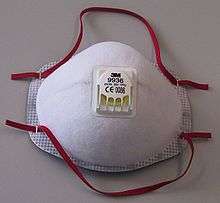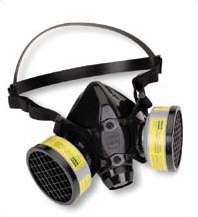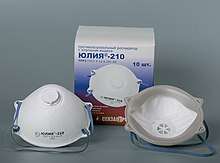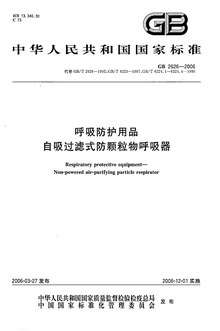Mechanical filter respirator
Mechanical filter respirators are a class of respirator that removes particulates from the air using a filter that mechanically stops them from reaching the wearer's nose and mouth.

Mechanism of operation
Mechanical filter respirators retain particulate matter such as dust created during woodworking or metal processing, when contaminated air is passed through the filter material. Wool is still used today as a filter, along with plastic, glass, cellulose, and combinations of two or more of these materials. Since the filters cannot be cleaned and reused and have a limited lifespan, cost and disposability are key factors. Single-use, disposable and replaceable cartridge models exist.[1]
Mechanical filters remove contaminants from air in the following ways:
- by interception when particles following a line of flow in the airstream come within one radius of a fiber and adhere to it;[1]
- by impaction, when larger particles unable to follow the curving contours of the airstream are forced to embed in one of the fibers directly; this increases with diminishing fiber separation and higher air flow velocity[1]
- by an enhancing mechanism called diffusion, where gas molecules collide with the smallest particles, especially those below 100 nm in diameter, which are thereby impeded and delayed in their path through the filter; this effect is similar to Brownian motion and increases the probability that particles will be stopped by either of the two mechanisms above; it becomes dominant at lower air flow velocities[1]
- by using certain resins, waxes, and plastics as coatings on the filter material to attract particles with an electrostatic charge that holds them on the filter surface;
- by using gravity and allowing particles to settle into the filter material (this effect is typically negligible); and
- by using the particles themselves, after the filter has been used, to act as a filter medium for other particles.
Considering only particulates carried on an air stream and a fiber mesh filter, diffusion predominates below the 0.1 μm diameter particle size. Impaction and interception predominate above 0.4 μm. In between, near the 0.3 μm most penetrating particle size, diffusion and interception predominate.[1]
For maximum efficiency of particle removal and to decrease resistance to airflow through the filter, particulate filters are designed to keep the velocity of air flow through the filter as low as possible. This is achieved by manipulating the slope and shape of the filter to provide larger surface area.
A substantial advance in mechanical filter technology was the HEPA filter. A HEPA filter can remove as much as 99.97% of all airborne particulates with aerodynamic diameter of 0.3 μm, particles both smaller and larger are removed with an efficiency >99.97%.[2]

Physical form
Filtering facepiece respirators

Disposable filtering facepiece respirators (such as N95 masks) are discarded when they become unsuitable for further use due to considerations of hygiene, excessive resistance, or physical damage.[3]
Elastomeric respirators
Elastomeric respirators are reusable devices with exchangeable cartridge filters that offer comparable protection to N95 masks.[4] The filters must be replaced when soiled, contaminated, or clogged.[5]
They may have exhalation valves. Full-face versions of elastomeric respirators seal better and protect the eyes. Fitting and inspection is essential to effectiveness.[5]
Powered air-purifying respirators (PAPRs)
PAPRs are masks with a electricity-powered blower that blows air through a filter to the wearer. Because they create positive pressure, they need not be tightly-fitted.[6] PAPRs typically do not filter exhaust from the wearer.[7]
Filtration standards
U.S. standards (N95 and others)
In the United States, the National Institute for Occupational Safety and Health defines the following categories of particulate filters according to their NIOSH air filtration rating as of 2011:[8]
| Oil resistance | Rating | Description |
|---|---|---|
| Not oil resistant | N95 | Filters at least 95% of airborne particles |
| N99 | Filters at least 99% of airborne particles | |
| N100 | Filters at least 99.97% of airborne particles | |
| Oil resistant | R95 | Filters at least 95% of airborne particles |
| R99 | Filters at least 99% of airborne particles | |
| R100 | Filters at least 99.97% of airborne particles | |
| Oil proof | P95 | Filters at least 95% of airborne particles |
| P99 | Filters at least 99% of airborne particles | |
| P100 | Filters at least 99.97% of airborne particles |
European standards (FFP2 and others)

European standard EN 143 defines the 'P' classes of particle filters that can be attached to a face mask, and European standard EN 149 defines the following classes of "filtering half masks" or "filtering face pieces" (FFP), that is respirators that are entirely or substantially constructed of filtering material:[9]
| Class | Filter Type | Filter penetration limit (at 95 L/min air flow) | Inward leakage | Typical Elastic Band |
|---|---|---|---|---|
| FFP1 | Mask | Filters at least 80% of airborne particles | <22% | Yellow |
| FFP2 | Filters at least 94% of airborne particles | <8% | Blue or White | |
| FFP3 | Filters at least 99% of airborne particles | <2% | Red | |
| P1 | Attachment | Filters at least 80% of airborne particles | N/A | N/A |
| P2 | Filters at least 94% of airborne particles | |||
| P3 | Filters at least 99.95% of airborne particles |
Both European standard EN 143 and EN 149 test filter penetration with dry sodium chloride and paraffin oil aerosols after storing the filters at 70 °C and −30 °C for 24 h each. The standards include testing mechanical strength, breathing resistance and clogging. EN 149 tests the inward leakage between the mask and face, where 10 human subjects perform 5 exercises each. The truncated mean of average leakage from 8 individuals must not exceed the aforementioned values.[10](§ 8.5)
Other standards (KN95 and others)

Respirator standards around the world loosely fall into the two camps of US- and EU- like grades. According to 3M, respirators made according to the following standards are equivalent to US N95 or European FFP2 respirators "for filtering non-oil-based particles such as those resulting from wildfires, PM 2.5 air pollution, volcanic eruptions, or bioaerosols (e.g. viruses)":[11]
- Chinese KN95 (GB2626-2006): similar to US. EU-style leakage requirements. Has KN and KP, 95/99/100 version.
- Australian / New Zealand P2 (AS/NZ 1716:2012): similar to EU grades.
- Korean 1st Class (KMOEL - 2017-64), also referred to as "KF94": EU grades, KF 80/94/99 for second/first/special.[12]
- Japanese DS (JMHLW-Notification 214, 2018): see below
The NPPTL has also published a guideline for using non-NIOSH masks instead of the N95 in the COVID-19 response. The OSHA has a similar document. The following respirator standards are considered similar to N95 in the US:[13][14]
- Mexican N95 (NOM-116-2009): same grades as in NIOSH
- Brazilian PFF2 (ABNT/NBR 13698:2011): EU-like grades
- Japanese DS2 / RS2: EU-like grades with two-letter prefix – first letter D/R stands for disposable or replaceable; second letter S/L stands for dry (NaCl) or oily (DOP oil) particles[15]
References
- TSI Incorporated. "Mechanisms of Filtration for High Efficiency Fibrous Filters - Application Note ITI-041" (PDF). Retrieved 29 April 2020.
- Guidance for Filtration and Air-Cleaning Systems to Protect Building Environments from Airborne Chemical, Biological, or Radiological Attacks (PDF). Cincinnati, OH: National Institute for Occupational Safety and Health. April 2003. pp. 8–12. doi:10.26616/NIOSHPUB2003136. Retrieved February 9, 2020.
- "Respirator Trusted-Source Information: What are they?". U.S. National Institute for Occupational Safety and Health. 2018-01-29. Retrieved 2020-03-27.
- Bach, Michael. "Understanding respiratory protection options in Healthcare: The Overlooked Elastomeric". NIOSH Science Blog. CDC.
- "Coronavirus Disease 2019 (COVID-19)". Centers for Disease Control and Prevention. 11 February 2020.
- Boškoski, Ivo; Gallo, Camilla; Wallace, Michael B.; Costamagna, Guido (27 April 2020). "COVID-19 pandemic and personal protective equipment shortage: protective efficacy comparing masks and scientific methods for respirator reuse". Gastrointestinal Endoscopy. doi:10.1016/j.gie.2020.04.048. ISSN 0016-5107. PMC 7184993.
- "The Use and Effectiveness of Powered Air Purifying Respirators in Health Care: Workshop Summary. 2. Defining PAPRs and Current Standards". NCBI. May 7, 2015.
- Metzler, R; Szalajda, J (2011). "NIOSH Fact Sheet: NIOSH Approval Labels - Key Information to Protect Yourself" (PDF). DHHS (NIOSH) Publication No. 2011-179. ISSN 0343-6993.
- "Fiche pratique de sécurité ED 105. Appareils de protection respiratoire et métiers de la santé" (pdf). inrs.fr. INRS. Retrieved 7 April 2020.
- "NF EN 149+A1". www.boutique.afnor.org. Septembre 2009. Check date values in:
|date=(help) alternative source - "Technical Bulletin: Comparison of FFP2, KN95, and N95 and Other Filtering Facepiece Respirator Classes" (PDF). 3M Personal Safety Division. January 2020.
- Jung, Hyejung; Kim, Jongbo; Lee, Seungju; Lee, Jinho; Kim, Jooyoun; Tsai, Perngjy; Yoon, Chungsik (2014). "Comparison of Filtration Efficiency and Pressure Drop in Anti-Yellow Sand Masks, Quarantine Masks, Medical Masks, General Masks, and Handkerchiefs". Aerosol and Air Quality Research. 14 (3): 991–1002. doi:10.4209/aaqr.2013.06.0201.
- "NPPTL Respirator Assessments to Support the COVID-19 Response, International Respirator Assessment Request". NPPTL | NIOSH | CDC. 24 April 2020.
- "Enforcement Guidance for Use of Respiratory Protection Equipment Certified under Standards of Other Countries or Jurisdictions During the Coronavirus Disease 2019 (COVID-19) Pandemic". Occupational Safety and Health Administration.
- "Standard for Dust Mask". JICOSH Home.